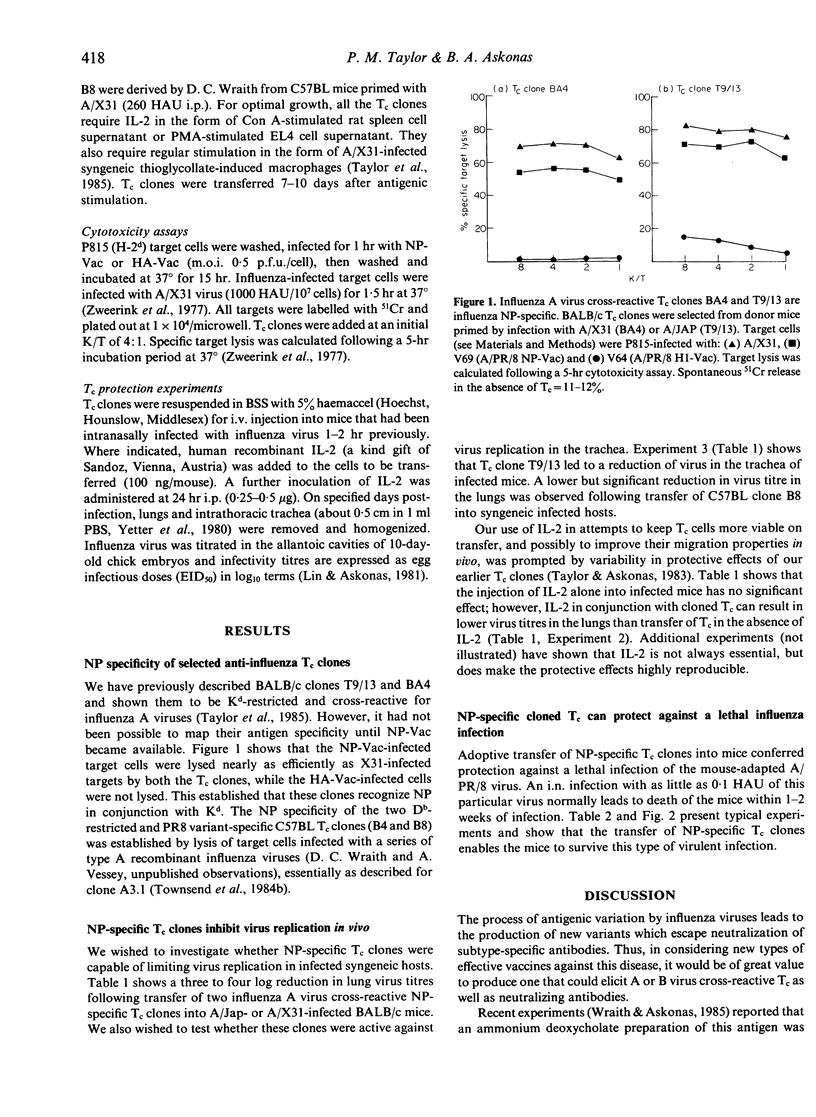Abstract
Influenza nucleoprotein (NP) serves as a target antigen on abortively infected cells for cytotoxic T cells (Tc) cross-reactive for all type A influenza viruses, and it can also prime mice for such Tc. It is important to test the protective ability of NP-specific Tc clones in vivo in a productive influenza infection. In this report, we show that Tc clones of this antigenic specificity protect mice against a lethal influenza infection on transfer to syngeneic recipients, and also that they reduce virus titres in the lungs and trachea of mice challenged with homologous or heterologous type A influenza viruses. Simultaneous injection of IL-2 to maintain the viability of the Tc clones is not essential, but has made the clonal transfer experiments highly reproducible.
Full text
PDF



Selected References
These references are in PubMed. This may not be the complete list of references from this article.
- Cheever M. A., Greenberg P. D. In vivo administration of interleukin-2. Contemp Top Mol Immunol. 1985;10:263–282. doi: 10.1007/978-1-4684-4838-2_11. [DOI] [PubMed] [Google Scholar]
- Dailey M. O., Fathman C. G., Butcher E. C., Pillemer E., Weissman I. Abnormal migration of T lymphocyte clones. J Immunol. 1982 May;128(5):2134–2136. [PubMed] [Google Scholar]
- Lin Y. L., Askonas B. A. Biological properties of an influenza A virus-specific killer T cell clone. Inhibition of virus replication in vivo and induction of delayed-type hypersensitivity reactions. J Exp Med. 1981 Aug 1;154(2):225–234. doi: 10.1084/jem.154.2.225. [DOI] [PMC free article] [PubMed] [Google Scholar]
- Lukacher A. E., Braciale V. L., Braciale T. J. In vivo effector function of influenza virus-specific cytotoxic T lymphocyte clones is highly specific. J Exp Med. 1984 Sep 1;160(3):814–826. doi: 10.1084/jem.160.3.814. [DOI] [PMC free article] [PubMed] [Google Scholar]
- Pala P., Townsend A. R., Askonas B. A. Viral recognition by influenza A virus cross-reactive cytotoxic T (Tc) cells: the proportion of Tc cells that recognize nucleoprotein varies between individual mice. Eur J Immunol. 1986 Feb;16(2):193–198. doi: 10.1002/eji.1830160215. [DOI] [PubMed] [Google Scholar]
- Rouse B. T., Miller L. S., Turtinen L., Moore R. N. Augmentation of immunity to herpes simplex virus by in vivo administration of interleukin 2. J Immunol. 1985 Feb;134(2):926–930. [PubMed] [Google Scholar]
- Smith G. L., Murphy B. R., Moss B. Construction and characterization of an infectious vaccinia virus recombinant that expresses the influenza hemagglutinin gene and induces resistance to influenza virus infection in hamsters. Proc Natl Acad Sci U S A. 1983 Dec;80(23):7155–7159. doi: 10.1073/pnas.80.23.7155. [DOI] [PMC free article] [PubMed] [Google Scholar]
- Taylor P. M., Askonas B. A. Diversity in the biological properties of anti-influenza cytotoxic T cell clones. Eur J Immunol. 1983 Sep;13(9):707–711. doi: 10.1002/eji.1830130904. [DOI] [PubMed] [Google Scholar]
- Taylor P. M., Wraith D. C., Askonas B. A. Control of immune interferon release by cytotoxic T-cell clones specific for influenza. Immunology. 1985 Apr;54(4):607–614. [PMC free article] [PubMed] [Google Scholar]
- Townsend A. R., Skehel J. J., Taylor P. M., Palese P. Recognition of influenza A virus nucleoprotein by an H-2-restricted cytotoxic T-cell clone. Virology. 1984 Mar;133(2):456–459. doi: 10.1016/0042-6822(84)90413-6. [DOI] [PubMed] [Google Scholar]
- Wraith D. C., Askonas B. A. Induction of influenza A virus cross-reactive cytotoxic T cells by a nucleoprotein/haemagglutinin preparation. J Gen Virol. 1985 Jun;66(Pt 6):1327–1331. doi: 10.1099/0022-1317-66-6-1327. [DOI] [PubMed] [Google Scholar]
- Yetter R. A., Lehrer S., Ramphal R., Small P. A., Jr Outcome of influenza infection: effect of site of initial infection and heterotypic immunity. Infect Immun. 1980 Aug;29(2):654–662. doi: 10.1128/iai.29.2.654-662.1980. [DOI] [PMC free article] [PubMed] [Google Scholar]
- Yewdell J. W., Bennink J. R., Smith G. L., Moss B. Influenza A virus nucleoprotein is a major target antigen for cross-reactive anti-influenza A virus cytotoxic T lymphocytes. Proc Natl Acad Sci U S A. 1985 Mar;82(6):1785–1789. doi: 10.1073/pnas.82.6.1785. [DOI] [PMC free article] [PubMed] [Google Scholar]
- Zweerink H. J., Askonas B. A., Millican D., Courtneidge S. A., Skehel J. J. Cytotoxic T cells to type A influenza virus; viral hemagglutinin induces A-strain specificity while infected cells confer cross-reactive cytotoxicity. Eur J Immunol. 1977 Sep;7(9):630–635. doi: 10.1002/eji.1830070910. [DOI] [PubMed] [Google Scholar]


